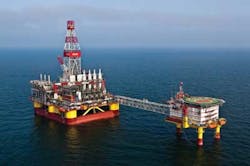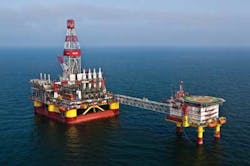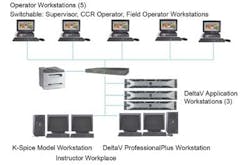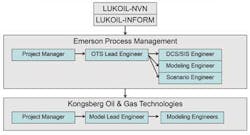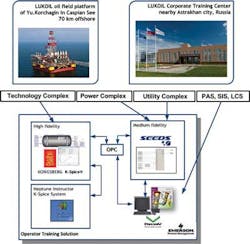High-accuracy simulator trains offshore oil platform operators
Ilya Vasilyevych Fotin
LUKOIL
Viacheslav Kulikov
Emerson Process Management
LUKOIL has deployed an offshore training simulator (OTS) at its corporate training center near Astrakhan,Russia, that enables its employees to become familiar with exactly the same type of equipment and systems they will use in the field.
The OTS features a modern control system from Emerson Process Management and modeling software from Kongsberg, and was developed with the same Emerson developers who configured LUKOIL's North Caspian Sea platform in the Yuri Korchagin oil field. The following reviews the development of that training center and explains how it operates.
Production facilities
In 1995, LUKOIL began to investigate a previously unexplored area in the northernCaspian Sea. Exploratory drilling began in 1999, and the first production platform began operating in April 2010, with five more fields to be developed by 2017. The company realized the need for trained operators to work safely and consistently, so they embarked on a program to develop a center to provide operators with the most up-to-date and complete training possible.
The platform is located about 70 km (43.5 mi) offshore in theYuri Korchagin oil field, and while the water is not very deep – 11 to 13 m (36 to 43 ft) – the operating conditions can be severe, with low temperatures, ice fields, and strong winds. The complex consists of two platforms: the production platform, LSP-1, and the habitation platform, LSP-2, which accommodates up to 105 employees and is connected to the production platform by an elevated walkway. There can be as many as five shifts on the platform at one time.
Oil produced by the platform is transported 58 km (36 mi) to a floating storage unit via a 300-mm (12-in.) subsea pipeline. The main production facility is powered by extracted gas, backed up by diesel motors when necessary.
The platform uses a modern distributed control system (DCS) from Emerson Process Management: a DeltaV distributed control system, DeltaV SIS (safety instrumented system), AMS Suite plant asset management software, and the controls for the platform's fire and gas systems. The total I/O comes to about 14,000 points.
Need for training
Training is vital for proper and safe operation. At one time, LUKOIL conducted operations training onboard the platform, but it quickly became apparent that this was not a safety arrangement. The company started planning an onshore training facility, and in 2011 opened a corporate training center in the suburbs of the nearby city of Astrakhan. Initially aimed at training in firefighting and other emergency procedures, the center has grown into a multi-purpose training facility for safety training (fire and gas, sea rescue, and first aid training) as well as instrumentation and offshore operations training, focusing on skills development for operations and engineering staff. Operators are trained in safe and efficient process operation; process knowledge development; knowledge of process control systems; and startup, shutdown, and abnormal situation handling skills. The center has a capacity of 2,500 trainees per year.
The safety training is realistic, and even includes a mockup of a helicopter that can be filled with people and then dropped into a water tank so that trainees can learn to escape a crash at sea. It also provides realistic fire training, with instruction in the use of fire extinguishers and the various fire-fighting systems on the platform.
A similar level of realism is necessary for operator and supervisor training to prevent process upsets, lost production, spills (the entire production operation operates under a strict no-discharge rule), and danger to personnel. This means that the simulated control system on which the training is done must exactly duplicate the control system on the platform.
OTS architecture and functions
Key to achieving that realism is the operator training simulator (OTS), which is designed to replicate exactly the platform's equipment, and was developed with the same Emerson developers who had developed the configuration for the production platform. The idea was to train operators on exactly the same equipment that they would be using in the field, and the OTS uses the same hardware as the platform's DCS and SIS, and runs the same software. It is set up to match the as-installed system, not a "functional equivalent" built from preliminary designs, and uses simulation software that duplicates the configuration exactly as on site: the DCS configuration is an exact copy of the one on the platform, the SIS configuration and emergency shutdown algorithms are exact copies, and the fire and gas alarm configuration is an exact copy. The OTS allows trainees to perform control, start-up, and shutdown procedures for major platform systems, and all scenarios and training courses are customized and configurable.
Hardware for the OTS includes five PC workstations that are connected to the control system emulator that executes the actual control system's DCS/SIS algorithms, using simulated values as the inputs. The PCs can be switched to operate as supervisor workstations, central control room (CCR) operator workstations, or field operator workstations. They connect via a local area network to the instructor workspace, which includes three DeltaV application workstations, a K-Spice model workstation and a DeltaV ProfessionalPlus workstation. Operator screens are exact copies of the operator screens on the platform, and all complexes and systems are available to the central control room operators. Operator screen access level for the technology, power and utility complexes is privilege dependent. Field operator screens emulate the actions of field operator such as opening manual valves and field equipment operation.
The OTS hardware and software are divided into three main parts: control system emulation, a process model and simulator, and facilities for the organization of training, evaluation, and courseware.
Control system model
The control system emulation, as mentioned, is an exact copy of the control system configuration for the platform's DCS, the emergency shutdown system and the fire and gas detection systems. It also provides emulations for local control systems, including compressor startup and anti-surge controls, power generation, and glycol block.
Process model and simulator
The process model, which runs on its own server, calculates process parameters with high accuracy, taking DCS/SIS outputs from the control system emulator as inputs. It has two parts: A high-fidelity technology complex model handles oil and gas production, separation and transport, while a medium-fidelity power and utility complex model handles power generation and distribution, auxiliary systems and life support, where high accuracy is not required.
Technology complex model
The high-fidelity technology complex process model uses K-Spice, from Kongsberg Oil and Gas Technologies. The K-Spice model for the technology complex includes models for 26 production wells plus gas lift, three gas injection wells, and three water injection wells. It also models oil separation, preparation and transport system, the gas compression and injection, fuel gas system, the water treatment system, the TEG (triethylene glycol) system, as well as auxiliaries: chemical injection, flares, drainage, etc. It can be modified and expanded as necessary. Integration with the DCS and SIS system is via a standard OPC server and a custom K-Spice/DeltaV interface. More than 6,000 parameters are interfaced between K-Spice and DeltaV.
Power and utility model
The medium-fidelity power and utility process model uses the SEEDS (Standard Entities for the Engineering of Dynamic Simulators) platform, a medium-fidelity native dynamic simulation that provides a realistic and effective simulation environment within a single integrated database. It includes the models for the power generation system (gas turbine generator and emergency generator); the power distribution system; the diesel fuel and oil system for power objects; the waste heat recovery systems; the life support systems within the production platform; the fire extinguishing systems; and the auxiliary process systems, including water supply, cooling/heating agent, drainage, etc. The SEEDS model also interfaces to the K-Spice model.
Instructor station
The instructor workstation provides an HMI for the instructor and handles instructor functions and operator evaluation. It runs Neptune Instructor, a monitoring and assessment system from Kongsberg Maritime, which is used to set up scenarios and evaluate the actions from the operators and their responses to the circumstances and scenarios given by the instructors.
Project execution and schedule
The project was implemented in three stages. Stage 1, which ran from November through December 2011, was devoted to input data collection and project design. Project data was collected and analyzed in detail, and missing data identified. The initial design was then developed and sent for approval.
Stage 2, which covered the technology and power complex, ran from January to September 2012. It included the development of the Technology Complex model in K-Spice, the development of the Power Complex model in SEEDS, the transfer of copies of the DCS/SIS configuration and operator screens to OTS and field operator screens, system integration, and the model acceptance test.
Stage 3, which ran from October to December 2012, covered the utility complex and training organization. It included development of the utility complex model in SEEDS, development of scenarios and training courseware and trial operation and site acceptance.
Organization of training
A typical training class consists of an instructor at the instructor workstation to load training scenarios and conduct the session, while at the five operator workstations might be a shift lead, a senior operator, a production operator, a power operator and a field operator. The training instructor can choose among 29 customized shift training scenarios ranging from alarm reaction training to full-scale platform startup, and can configure and modify scenarios and introduce events and malfunctions as needed. Trainees are provided with scenario-based courseware to study, and their performance is automatically evaluated in the Neptune Instructor system.
Key success factors
A number of factors contributed to the success of the project. All needed input data was available from both LUKOIL and Emerson, and starting to collect that data early in the project allowed time for data analysis and mining. Similarly, starting early on the task of integration tests resulted in seamless integration. The engineers involved were well experienced; both the project manager and the DCS/SIS engineer participated in the Korchagin DCS project and know the system well. The Emerson and Kongsberg offices collaborated extensively. And the LUKOIL instructor and chief engineers provided their full support and expertise.
Results and future plans
The training system was successfully delivered to the LUKOIL Corporate Training Center on time, on budget, and in full scope. LUKOIL operating and engineering staff are now trained in a realistic environment onshore before going offshore. The system has proven to be a high-fidelity solution for both staff training and engineering studies, with scenario-based courseware and evaluation for various training levels – from beginners to experienced operators. Operators and engineers gain increased knowledge, and on-site operational safety is improved.
The OTS has made possible an expansion of LUKOIL Corporate Training Center offerings with offshore oil production training. The system will support the company's operations at the Yuri Korchagin field throughout the platform lifecycle, and the training facility will support operations at new oil fields as they are developed in 2015 through 2017.
The authors
Ilya Fotin is the Chief Metrologist, Chief of Automation and Metrology department of LUKOIL-Nizhnevolzhskneft, LUKOIL Oil Co., Russia, with 25 years of experience in the oil and gas industry. He began his career as a control instrumentation technician at oil production facilities in Perm region. His further career included the positions of chief technician, the head of laboratory and the head of automation, IT and communications department in LUKOIL-Perm branch of LUKOIL Oil Co. In 2004 he moved to LUKOIL-Nizhnevolzhskneft (North Caspian Region) where LUKOIL began development of its offshore oil production facilities. He participated in development of the Yuri Korchagin oil field and was responsible for the development, commissioning, and operation of the instrumentation, automation, control, and safety systems at the offshore oil production platform and FSO. His current responsibilities include supervision of the operation of instrumentation and automation as well as participation in the development of further offshore facilities at the oil fields in the North Caspian Region. He can be reached at[email protected].
Viacheslav Kulikov is senior consultant and group leader of Strategic Services CIS, Emerson Process Management with six years of experience in industry and five years in academia. He has a Ph.D. from RWTH Aachen University, Germany. Following the graduation he started his career at Emerson Process Management as advanced process control engineer. Starting from 2011 he became a lead engineer for advanced process control and operator training simulator projects. In 2013, he was promoted to senior consultant position and became responsible for development of Strategic Services CIS group of experts in advanced solutions in process automation. He can be reached at[email protected].
